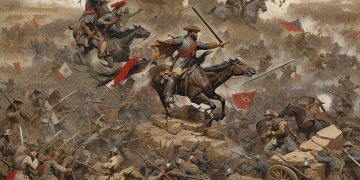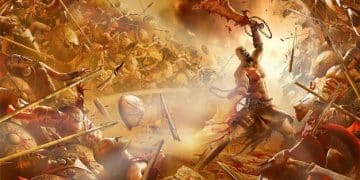The Battle of Thermopylae: Tactical Brilliance of the Spartan Stand
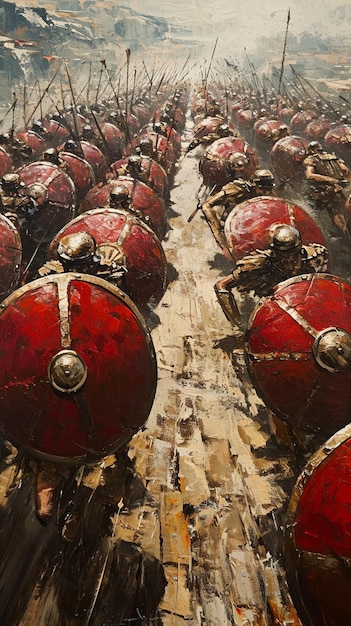
The Battle of Thermopylae, a legendary clash in 480 BC, showcases the tactical brilliance of the Spartan-led Greek forces, who, despite being heavily outnumbered, utilized the narrow pass to delay the Persian advance, buying crucial time for the rest of Greece to prepare its defense.
The Battle of Thermopylae: Examining the Tactical Significance of the Spartan Stand remains one of history’s most iconic military engagements. Far more than just a tale of bravery, it was a masterclass in tactical thinking and defensive warfare, a testament to the Spartan army’s discipline, training, and understanding of the battlefield.
Understanding the Strategic Context of Thermopylae
Before delving into the tactical nuances of the battle, it’s crucial to understand why Thermopylae was so strategically important. The pass itself represented a choke point, a narrow corridor between the mountains and the sea that controlled access to central Greece.
Control of this pass meant control of the Greek mainland. Losing it would open the way for Xerxes’ massive Persian army to march unimpeded towards Athens and other major Greek cities, effectively ending any hope of Greek resistance. The decision to defend Thermopylae was, therefore, a calculated gamble to buy time and protect the heart of Greece.
The Geography of Thermopylae
The pass at Thermopylae was not just narrow; it was also strategically varied. The terrain consisted of several bottlenecks, offering opportunities for a smaller force to defend against a much larger one. The Spartans, under the leadership of King Leonidas, carefully chose their positions to maximize these advantages.
The Persian Objective
The Persians aimed to conquer and subjugate Greece. Xerxes, the Persian king, led a massive army and navy, intending to crush any resistance and incorporate Greece into his vast empire. Thermopylae was a critical step in this campaign, a gateway that needed to be forced open.
Understanding the strategic urgency for both sides highlights the importance of the Spartan’s tactical decisions. They were not simply fighting for honor; they were fighting for the survival of their way of life.
- The narrow pass controlled access to central Greece.
- Strategic chokepoints offered defensive advantages.
- The Persians sought to conquer and subjugate Greece.
The strategic context of the battle emphasizes the importance of the Spartan’s tactical decisions, making it clear why their defense, while ultimately unsuccessful in preventing the Persian advance, had such a lasting impact.
Leonidas: The Mind Behind the Spartan Stand
King Leonidas, the leader of the Spartan contingent at Thermopylae, was not just a warrior; he was a skilled tactician. His decisions leading up to and during the battle proved critical to the Greek’s ability to hold the pass for as long as they did.
Leonidas understood the strengths and weaknesses of both his own forces and the Persian army. He knew that the Spartans, with their superior training and discipline, could hold their own in close combat, especially in a confined space.
Strategic Deployment
Leonidas carefully positioned his troops to take advantage of the terrain. He placed his best warriors, the Spartans and other elite Greek soldiers, in the most vulnerable areas of the pass, ensuring that the Persians would face the toughest resistance where it mattered most. He also used the terrain to funnel the Persian advance, minimizing their numerical advantage.
Psychological Warfare
Leonidas also understood the importance of psychological warfare. The Spartans’ unwavering discipline and refusal to retreat, even in the face of overwhelming odds, sent a clear message to the Persians: they were not going to give up easily. This defiance likely had a demoralizing effect on the Persian troops, who were used to facing less determined opponents.
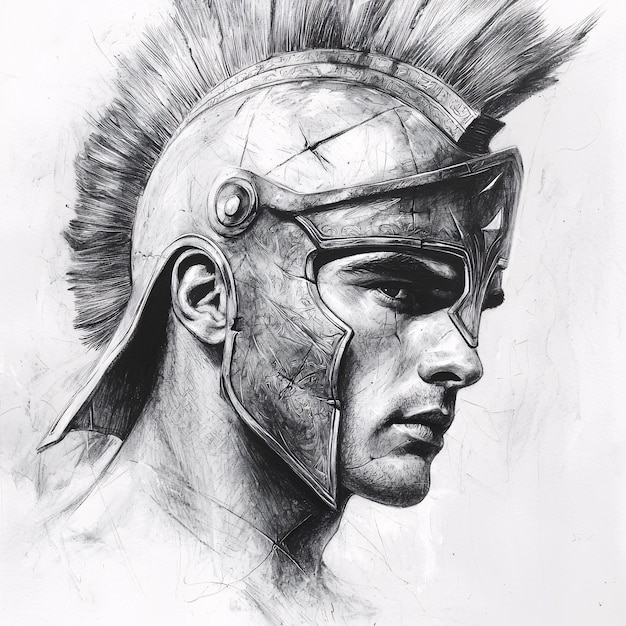
Leonidas’s leadership and tactical acumen were essential to the Spartan’s success at Thermopylae. He understood the importance of discipline, terrain, and psychological warfare and utilized them to maximize his forces’ effectiveness.
- Leonidas understood the strengths and weaknesses of both armies.
- He strategically deployed his troops to maximize terrain advantages.
- He utilized psychological warfare to demoralize the Persian army.
Leonidas’s tactical brilliance was a key factor in the Spartan’s ability to hold Thermopylae for as long as they did, buying crucial time for the rest of Greece to prepare for the Persian invasion.
The Spartan Military Doctrine: Superior Training and Equipment
The Spartan army was renowned throughout Greece for its discipline, training, and equipment. These factors played a significant role in their ability to withstand the Persian onslaught at Thermopylae.
From a young age, Spartan boys were trained in the art of warfare, instilling in them a sense of duty, discipline, and unwavering loyalty to their city-state. This rigorous training transformed them into highly skilled and formidable warriors.
The Hoplite Formation
The Spartan army was organized around the hoplite formation, a tightly packed phalanx of heavily armed infantrymen. This formation provided both offensive and defensive strength, allowing the Spartans to deliver devastating blows while also protecting themselves from enemy attacks.
Superior Weaponry
The Spartans were also equipped with superior weaponry, including long spears, short swords, and sturdy shields. Their shields were particularly important, as they were used to protect not only themselves but also their comrades to the left, emphasizing the importance of teamwork and cohesion within the phalanx.
The superior training and equipment of the Spartan army gave them a significant advantage over the Persian forces at Thermopylae. Their discipline and skill allowed them to effectively utilize the hoplite formation and withstand the Persian’s numerical superiority.
- Rigorous training instilled discipline and loyalty.
- The hoplite formation provided offensive and defensive strength.
- Superior weaponry gave them an edge in close combat.
The Spartan military doctrine, with its emphasis on discipline, training, and equipment, was a key factor in their success at Thermopylae. It allowed them to stand their ground against a much larger and more diverse army and inflict heavy casualties.
Exploiting the Terrain: The Bottlenecks of Thermopylae
The narrow pass of Thermopylae presented a unique opportunity for the Greeks to negate the Persian’s overwhelming numerical advantage. The terrain was strategically divided into several bottlenecks, natural formations that significantly restricted the space available for combat.
These bottlenecks forced the Persian army to fight in small groups, negating their ability to bring their full force to bear. The Spartans and other Greek soldiers, fighting in their tightly packed hoplite formation, could effectively block the Persian advance.
The “Hot Gates”
One of the most famous bottlenecks was known as the “Hot Gates,” a narrow passage near hot springs. This passage was so narrow that only a few soldiers could pass through at a time, making it an ideal defensive position for the Greeks.
Lateral Movements
The terrain also allowed the Greeks to make lateral movements, flanking the Persians and disrupting their formations. This tactic was particularly effective in confusing and disorienting the Persian troops, who were not used to fighting in such confined spaces.
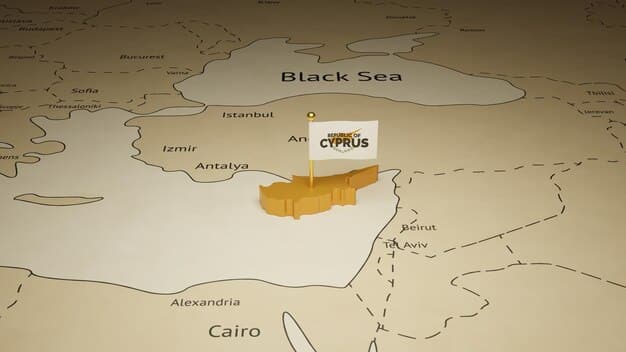
By exploiting the terrain, the Spartans and their allies were able to turn Thermopylae into a killing field, inflicting heavy casualties on the Persian army and slowing their advance significantly.
The strategic use of terrain at Thermopylae was a testament to the Spartans’ tactical acumen. By effectively utilizing the bottlenecks and making calculated lateral movements, they were able to neutralize the Persian’s numerical superiority and inflict significant damage on the enemy.
- Bottlenecks negated the Persian’s numerical advantage.
- The “Hot Gates” provided an ideal defensive position.
- Lateral movements disrupted Persian formations.
The exploitation of terrain was a crucial aspect of the Spartan’s tactical brilliance at Thermopylae. It allowed them to dictate the terms of the engagement and maximize their defensive capabilities.
The Role of Allied Forces: Beyond the 300 Spartans
While the 300 Spartans have become the symbol of Thermopylae, it’s important to remember that they were not alone. A significant contingent of allied forces from other Greek city-states also participated in the battle, playing a crucial role in the defense of the pass.
These allied forces included soldiers from Thebes, Thespiae, and other regions of Greece. While they may not have been as rigorously trained or as renowned as the Spartans, they were still skilled warriors who fought bravely alongside their Spartan comrades.
Maintaining Formations
The allied forces were essential in maintaining the integrity of the Greek battle line. They helped to fill the gaps created by casualties and provided support to the Spartans, preventing the Persians from breaking through the defensive perimeter.
Protecting the Flanks
Some of the allied forces were also stationed on the flanks of the Greek position, protecting it from encirclement. This was particularly important, as the Persians could have potentially outflanked the Greeks and attacked them from behind.
The contribution of the allied forces should not be underestimated. While the Spartans may have been the most elite warriors, they could not have held Thermopylae without the support and dedication of their Greek allies.
The role of allied forces at Thermopylae underscores the importance of unity and cooperation in the face of a common enemy. The Greeks, despite their often-divided city-states, were able to come together to defend their homeland against the Persian invasion.
- Allied forces maintained the integrity of the Greek battle line.
- They helped to fill gaps created by casualties.
- They protected the flanks from encirclement.
The presence and contribution of the allied forces were critical to the Greek’s ability to withstand the Persian advance at Thermopylae, showcasing the strength of a united front.
The Betrayal and the Fall: The End of the Spartan Stand
Despite their tactical brilliance and unwavering courage, the Spartans and their allies were ultimately defeated at Thermopylae. A local resident named Ephialtes betrayed the Greeks by revealing a secret path that allowed the Persians to outflank their position.
When Leonidas learned of the betrayal, he made the difficult decision to dismiss the majority of his troops. He knew that the battle was lost and that most of the allied forces would not stand a chance against the Persians in an open engagement. However, he chose to remain at Thermopylae with a small contingent of Spartans and Thespians, determined to fight to the death.
The Final Stand
The final stand of the Spartans and Thespians at Thermopylae has become legendary. They fought with unmatched ferocity, inflicting heavy casualties on the Persians even as they were surrounded and outnumbered. Ultimately, they were all killed, but their sacrifice bought valuable time for the rest of Greece to prepare for the Persian invasion.
A Pyrrhic Victory
While the Persians ultimately won the battle of Thermopylae, their victory came at a high cost. The Spartans and their allies inflicted heavy casualties on the Persian army, slowing their advance and weakening their forces.
The betrayal and the fall of Thermopylae do not diminish the significance of the Spartan stand. Their tactical brilliance, unwavering courage, and ultimate sacrifice inspired the rest of Greece to resist the Persian invasion, ultimately leading to the Persian’s defeat at the battles of Salamis and Plataea.
- Ephialtes betrayed the Greeks, revealing a secret path.
- Leonidas dismissed most of his troops, choosing to remain with a small guard.
- The final stand bought valuable time for the rest of Greece.
The events surrounding the betrayal and the fall of Thermopylae highlight the tragic end of a heroic stand, but also underscore the lasting impact of the Spartan’s sacrifice on the course of the Greco-Persian Wars.
| Key Point | Brief Description |
|---|---|
| 🛡️ Strategic Location | Thermopylae’s narrow pass controlled access to central Greece. |
| ⚔️ Spartan Tactics | Utilized terrain and disciplined formations against Persian numbers. |
| 🤝 Allied Forces | Greek allies supported the Spartans, bolstering their defense. |
| 😢 Ultimate Sacrifice | The Spartans’ final stand bought time for Greek preparations. |
Frequently Asked Questions
▼
Thermopylae was the gateway to central Greece. Controlling it meant controlling access to important cities like Athens, making it a critical strategic point during the Persian invasion.
▼
The Spartan army’s effectiveness stemmed from their rigorous training, unwavering discipline, and mastery of the hoplite formation, making them formidable warriors in close combat.
▼
Ephialtes, a local resident, betrayed the Greeks by revealing a secret path that allowed the Persian army to outflank the Greek position at Thermopylae.
▼
The Spartan’s final stand at Thermopylae, though a defeat, bought valuable time for the rest of Greece to prepare its defenses and ultimately resist the Persian invasion.
▼
No, while 300 Spartans were present, a significant number of soldiers from other Greek city-states fought alongside them, contributing to the overall defense of Thermopylae.
Conclusion
The Battle of Thermopylae, despite the Greek defeat, remains a timeless example of tactical brilliance, unwavering courage, and the impact of strategic decision-making. The Spartan’s ability to exploit the terrain, utilize their superior training, and fight to the last man bought crucial time for Greece, ultimately contributing to the repulsion of the Persian invasion and solidifying their place in history as legendary warriors.
